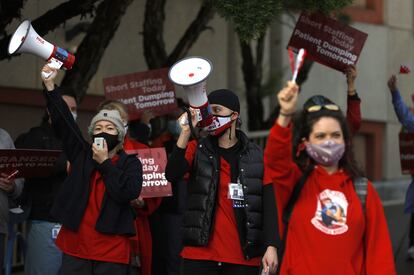The Great Resignation: Why four million US workers a month are leaving their jobs
The vast number of people opting for a different way of life due to the coronavirus pandemic is leading to a ‘seismic shift’ in the labor market and around 10 million current vacancies


Exit interviews are a tradition in the United States, a genre of their own in human resources management. Companies use exit interviews for employees who are leaving voluntarily, to find out what went wrong and the reasons the company failed to meet the expectations of its worker. Judging by the exodus of employees from the US labor market since the post-pandemic recovery kicked in, the conclusions these interviews reach are even more relevant today. They help to shed light on why, since April, when the first spike in resignations was recorded, around four million Americans a month have decided to leave the active labor market of their own volition, in many cases without another job lined up or any immediate intention of looking for one.
One of the factors often mentioned to explain the phenomenon is savings made thanks to federal economic aid initiatives, but it is not the only one. The situation is a tangled skein, with circumstantial threads and a structural core. Experts have baptized it The Great Resignation – a movement that existed before the pandemic but not at this pace – because the trend is sending shockwaves through the US culture of traditional work: professional performance as a priority in life, personal realization, projected through trade or career. Other observers have widened the focus and dubbed what is happening “the Great Remodeling,” a radical reformation of the culture of work, or even the Great Exhaustion, because in many cases those leaving are burned out or overworked by the system, with the pandemic acting as an accelerant.
That was the case with 67-year-old Phyllis Curran O’Neill. “I worked from July 2020 to September 2021 as a receptionist at an apartment complex for seniors in New Jersey, full time, for $12 an hour. The company offered medical and life insurance and a limited pension plan, but as I am over 65 and I have Medicare, I passed on the medical insurance. Medicare is better,” she says. In the US, private health insurance is paid for by employers, which often means having this benefit means getting paid less, or vice versa: more salary, less cover.
The straw that broke the camel’s back for O’Neill was overwork and, as a result, stress and emotional exhaustion. “As the months went by, I noticed that my list of responsibilities was growing until the point where one day I was so overwhelmed I blew up and shouted: ‘I want more money for this!’ Afterward I felt that my behavior had been unacceptable and decided it was time to call it a day. The management offered to keep me on as cover, but they have only called me once in two months when someone was ill.” Another characteristic of the US labor market: the numerous sick days employees take to avoid having their pay cut.
This mass exodus is hitting businesses too as they deal with a lack of available workers while also compromising the complete recovery of sectors such as retail and transport, which are now functionally deficient, as evidenced by the endless lines in front of closed cash registers in big department stores during peak hours. At the end of July, there were 11 million open jobs in the US. In September the number of people quitting stood at over 4.4 million, slightly more than August (4.3 million) in a population of 331 million. It is the largest percentage of resignations since records began two decades ago.
The lack of manpower has aggravated a system already ailing from the great global bottleneck in supply and distribution chains. Of the total number of workers to have quit their jobs, almost a million were employed in the leisure and catering sector, one of those that has recovered with the greatest speed. A further 863,000 were employed in industries related to accommodation and 706,000 were tradespeople. At the end of September there were 10.4 million vacant positions in the US, a slight drop over August, but still incredibly high by historical standards. There are approximately 75 unemployed workers for every 100 vacancies, the lowest figure in the last two decades.
Experts and the media speak about a seismic shake-up, of the social contract being re-written, thanks to which the traditional balance of power between employer and employee is now gradually leaning toward the latter. The growing empowerment of the worker goes some way to explaining the union mobilization that is sweeping the US, another phenomenon that has emerged from the pandemic. Workers now see themselves in a position to make demands, albeit sometimes overshooting. “We’ve turned down people who wanted $25 an hour. ‘For less than that I may as well stay at home cashing government checks,’ they told us. We can’t afford to pay $25 an hour because we still haven’t got back to pre-pandemic levels of business,” says Davide, who owns a trattoria in Manhattan.

The majority of workers who leave the labor market had reached a point of no return: their jobs demanded a psychological toll, sometimes even a physical one, that they were no longer willing to pay. Peter Christophe Atwill, 25, a graduate in Politics and Economics, left a job that on the face of it any one of his contemporaries would dream of because “I didn’t fit in, I never felt comfortable.” Two weeks ago, he left Bloomberg, where he worked as a business account manager. “I worked with tax advisors and accountants, helping them with tax returns through our platforms, so that they could increase the value of their business by better managing their expenses,” he says via telephone from Washington. But he did not enjoy the work and decided to take a new career turn, “knowing that I would be making half of what I got paid at Bloomberg.”
Atwill wants to work in social services, specifically in immigration, because his family arrived in America as immigrants. “It’s something very important to me, that’s why I think doing something that I see a purpose in will be much more fulfilling, even though I won’t earn as much.” For now, though, he is going to take some time out. “I’m optimistic. My parents were more worried than I was, but they’ve accepted it because they can see that I’m happy, which is all that matters to them.”
According to a recent study published in Harvard Business Review, Atwill does not belong to the most-represented age group involved in the Great Resignation: workers between the ages of 30 and 45, more than 20% of whom have left the labor market between 2020 and 2021. Mobility among young people, which is traditionally high, has been reduced over the past year due to economic uncertainty, the report states. The lack of any expectation of a promotion or a pay rise due to the pandemic among the mid-range age group goes some way to explaining this increase in the downing of tools. The most-affected sectors, according to the report, are those in which burnout are most common: healthcare (a 3.6% rise) and technology (4.5%). Both have experienced a huge rise in demand for new workers during the pandemic.
The Great Resignation exists among liberal professionals, but even more so among the less well-paid categoriesPatricia Campos-Medina, Executive Director of The Worker Institute at Cornell University
Patricia Campos-Medina, Executive Director of The Worker Institute at Cornell University, lists some of the factors contributing to this talent drain, among them dissatisfaction. “We have been through times of personal and financial anxiety. Many people weigh up the inconveniences of returning to a job without guarantees of security and no flexibility to look after their families. A lot of women have to take care of their children or elderly family members because what they would be earning by going to work wouldn’t pay enough to look after one person, this explains their decision to leave the labor market. The Great Resignation exists among liberal professionals, but even more so among the less well-paid categories. And it is happening in a similar way between unionized workers, who make up 10% of the total, and those who are not unionized. During the pandemic there was a backlash against the abuses of the big corporations, who multiplied their revenues. Many workers saw that they were mortgaging their lives for miserable salaries. In part it has been a reaction to this state of affairs.”
The argument that the Great Resignation has been driven by sloth or a lack of incentivization due to government payments or unemployment top-ups during the pandemic does not answer the root of the phenomenon, according to Campos-Medina. “Many people say that social benefits are keeping people out of the labor market, but pandemic-linked unemployment benefits expired in September and people are still not going back. And they are not going back because wages are not going up and there are no guarantees of flexibility.”
Fundamental change
The rules of the game that were in place before the pandemic no longer apply. Saying yes to everything, or to any job offer, has given way at the very least to hesitancy. “A fundamental change has taken place: there is now demand for responsibility from companies [in terms of job security, hygiene and social benefits] and also for public policies that protect the worker, which we have already seen during the pandemic,” says Campos-Medina, who believes the current crisis is also rooted in the proliferation of junk jobs over the past 20 years, above all “a notorious increase in part-time contracts, which allow companies to save on paying for social benefits such as medical insurance.”
The pandemic, therefore, can be said to have been the catalyst for a new type of worker, who is looking for a better work-life balance and for whom flexibility – and not only that which is theoretically inherent in working from home – is a key factor. “Although I do not use the concept of the Great Exhaustion, it reflects my view of what is happening. I think I will use it in the future, or perhaps the Great Re-evaluation,” says sociologist Mishal Khan of the University of Chicago via email. “I think that burnout is a very good reason, but there are others. I see this phenomenon as a collective referendum over the crisis and problems associated with work. People are fed up and are looking for alternatives to being exploited, degraded and making money for companies who don’t give enough back in return. Access to care is another major problem, as much in childcare as in affordable ways to look after senior citizens. Other people are opting to start their own businesses, getting into the gig economy or seeing self-employment as an attractive alternative, so that they don’t have to work for anyone. The fact that these opportunities exist may have given people the confidence to quit their jobs.”

In her exit interview from her last job, 36-year-old New York-based journalist Irene San Segundo found it difficult to enunciate negative motives for her decision to leave. “It was the best-paid job I’ve had, they treated me wonderfully… there was no force majeure, an illness, or anything like that. But the amount of Zoom meetings during the pandemic was the main reason that pushed me to decide, I was living on auto-pilot: 10-hour days, always online… it was Groundhog Day. Coronavirus accelerated the sense of time, it’s like we’ve lost two years. I had thought about leaving before the pandemic, with no savings, but Covid proved decisive in taking the step,” she says, adding that she hopes the Great Resignation “will lead to a change in priorities.”
“For the first time I have been given permission to choose; before it was just putting one foot in front of the other.” As in many other cases, the warning signs were there: “Not being able to sleep, or having to take pills to do so, anxiety… inability to disconnect or take days off because I knew that I wouldn’t be able to get my work done, or setting Sunday aside to finish things off.”
A month and a half after taking the plunge, having crunched the numbers and with some savings to fall back on, San Segundo feels like she has “won the lottery.” She has become much more involved in volunteer work for the elderly, which beforehand she only did when time allowed. She has a list of “nine-to-five” activities and wants to write for pleasure, not because she is obliged to. “If I had three wishes, I know what I’d pick first: time.” A reason that may soon be among the most common, written in triplicate and in capitals, on the list of reasons given at any exit interview.
Monique Jackson, a professional re-invention at Tulsa Remote
Monique Jackson, a 38-year-old graphic designer who specializes in advertising strategy on social media, left her job (“corporate America”, as she describes it) after suffering the full force of the pandemic: she lost three cousins and a family friend to Covid-19. “I realized that they were now unable to live their lives and that I couldn’t waste mine. I promised myself that I would end 2020 better than I started it,” says Jackson via email from Tulsa, Oklahoma. “I took a sabbatical to rediscover creativity without restrictions.” During her time-out she launched various projects, among them a podcast and her own design consultancy, “focused on empowering business and communities led by African American and Hispanic women. I am the daughter of a pastor and I have always been motivated by the vocation of service.”
It was during this transition period that she heard about Tulsa Remote, a program offering an annual subsidy of $10,000 to remote workers who were willing to relocate to Tulsa. At 36 Degrees North, the incubator for businesses and projects coming out of the program, Jackson found “valuable resources.”
“Connections with people who could help me to grow. I have found clients just by talking to friends and I haven’t even fully launched yet." In Tulsa, Jackson has re-invented herself professionally while still recovering from the emotional impact of Covid-19. “We learned a lot of lessons last year but the most important, for me, was that you can never take tomorrow for granted.”
Tu suscripción se está usando en otro dispositivo
¿Quieres añadir otro usuario a tu suscripción?
Si continúas leyendo en este dispositivo, no se podrá leer en el otro.
FlechaTu suscripción se está usando en otro dispositivo y solo puedes acceder a EL PAÍS desde un dispositivo a la vez.
Si quieres compartir tu cuenta, cambia tu suscripción a la modalidad Premium, así podrás añadir otro usuario. Cada uno accederá con su propia cuenta de email, lo que os permitirá personalizar vuestra experiencia en EL PAÍS.
¿Tienes una suscripción de empresa? Accede aquí para contratar más cuentas.
En el caso de no saber quién está usando tu cuenta, te recomendamos cambiar tu contraseña aquí.
Si decides continuar compartiendo tu cuenta, este mensaje se mostrará en tu dispositivo y en el de la otra persona que está usando tu cuenta de forma indefinida, afectando a tu experiencia de lectura. Puedes consultar aquí los términos y condiciones de la suscripción digital.
More information
Archived In
Últimas noticias
Most viewed
- Reinhard Genzel, Nobel laureate in physics: ‘One-minute videos will never give you the truth’
- Oona Chaplin: ‘I told James Cameron that I was living in a treehouse and starting a permaculture project with a friend’
- Pablo Escobar’s hippos: A serious environmental problem, 40 years on
- Why we lost the habit of sleeping in two segments and how that changed our sense of time
- Chevy Chase, the beloved comedian who was a monster off camera: ‘Not everyone hated him, just the people who’ve worked with him’










































